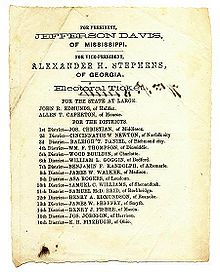President of the Confederate States

The President of the Confederate States ( Engl. President of the Confederate States of America ) was both head of state and head of government of the Confederate States , a confederation that its secession from the United States said. Jefferson Davis was the only person in office from February 18, 1861 to May 5, 1865. Its vice-president was Alexander Stephens . Before Davis was elected, Howell Cobb was the highest Confederate official as President of the Provisional Confederate Congress .
Office
Under the Confederate States' Constitution , the office of President of the Confederate States was almost the same as that of President of the United States .
- The president was elected by electors from each confederate state. Each state had as many electors as there were members of the Confederate Congress , senators and MPs.
- The president and a vice president were elected as running mate , but the president and vice president should not be citizens of the same state.
- The president had to be a citizen of either the Confederate States or the United States, born before December 20, 1860, and "resident of a Confederate state for fourteen years, provided that state consented to this constitution".
- The president had to be at least 35 years old.

Oath of office
Like the oath of office of the President of the United States , the oath of office of the President of the Confederate States was set out in the Confederate Constitution and was mandatory for a president to take office. The wording, almost an exact copy of the United States version, was required by the Constitution ( Article II, Section 1, Clause 10 ) as follows:
- "I do solemnly swear (or affirm) that I will faithfully execute the office of President of the Confederate States, and will, to the best of my ability, preserve, protect, and defend the Constitution thereof."
Like almost all Presidents of the United States, Jefferson Davis added the words “so help me God” to the end of the oath when he was sworn in on February 18, 1861.
Powers
The President of the Confederate States had almost the same powers as the President of the United States. However, it did not propose directly legislation, he had the authority members for the Supreme Court to nominate (Supreme Court) of the Confederate States, as well as ambassadors, cabinet ministers and other senior officials who have been confirmed by the Senate.
He was also commander (Engl. Commander-in-Chief ) of the Confederate armed forces ( Army , Navy and Marines ). Furthermore, he had a right of veto in the legislation .
The President could be charged by Congress with " treason , bribery or other serious crimes".
differences
There were some fundamental differences between the Confederate President and the President of the United States:
- While in the United States the President and Vice President could be re-elected indefinitely, which was only changed by the passage of the 22nd Amendment in 1951, the Confederate States limited the presidential term of office to a single six-year term. After the war , this innovation gained considerable support in the re-established Union, which was particularly well received by Rutherford B. Hayes in his inaugural address .
- The Confederate President also had the right to recommendations and requests for changes linked veto ( line-item veto ) regarding. Draft laws, a power that most governors had.
See also
Individual evidence
- ↑ a b c The Buffalo Soldier of the Western Frontier: South Dakota by Mickey L. Dennis, AuthorHouse, 2008, ISBN 978-1-4389-3420-4 , page 86
- ^ Provisional Constitution of the Confederate States. The University of North Carolina at Chapel Hill, February 21, 2012, accessed on February 21, 2012 (English, Provisional Constitution Art. II, Section 1, Clause 3).
- ^ A b The Rise and Fall of the Confederate Government, Volume 2 by Jefferson Davis, BiblioBazaar, LLC, 2009, ISBN 978-0-559-08770-7 , pages 625, 626, 628
- ↑ US Presidential Inaugural Addresses , Kessinger Publishing, 2004, ISBN 978-1-4191-9220-3 , pp. 124f
literature
- Acts passed at a General Assembly of the Commonwealth of Virginia , 1862, Chapter The Constitution of the Confederate States of America
- Studies on German constitutional law by Albert Haenel, BiblioBazaar, LLC, 2008, ISBN 978-0-554-81684-5 , pages 276ff
